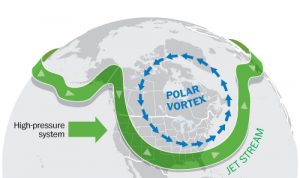
Temperatures in the -40s, colossal ice storms and frost warnings in Florida- do these sound like results of global warming?
To many they do not. The recent polar vortex affecting cities across North America has given global warming skeptics ammunition against the phenomenon, arguing that such cold temperatures cannot possibly indicate the earth is warming up.
Experts are saying the opposite.
Michael E. Mann, climatologist and director of the Earth System Science Centre at Pennsylvania State University, told the Toronto Star that evidence of global warming appears over time, not just in pockets of varying weather. He said that over the past decade North America has broken records for warm temperatures at twice the rate it has broken records for cold temperatures.
The Star also quotes Jennifer Francis, a researcher at the Institute of Marine and Coastal Sciences, Rutgers University, who equates the cold temperatures in North America to the disappearing ice in the Arctic – a well-known piece of evidence supporting global warming.
Melting ice in the Arctic is leading to more open water, which is less reflective of sunlight than ice. Francis says the lack of reflection is impacting the behaviour of the jet-stream, disrupting its path and pushing colder winds southwards towards Canada and the United States.
North America isn’t the only continent experiencing drastic weather. The Guardian reports that Australia is experiencing the warmest year of its history, with temperatures so high a new colour has been added to the weather forecast scale. A deep purple is now representing temperatures reaching over 50 Celsius.
And Australia is not alone in these heat waves – there was the European heat wave of 2003 and the Russian heatwave of 2010, resulting in thousands of premature deaths and millions of ruined crops.
While the polar vortex may seemingly be a ray of hope for those who don’t want to believe global warming exists, it seems like it is just another piece of evidence filed under global warming.
